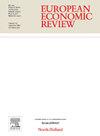解释制度技术
IF 2.8
2区 经济学
Q1 ECONOMICS
引用次数: 0
摘要
本文对Koppl et al.(2023)的《解释技术》(explained Technology)进行了回顾,并对其进行了一些改进和扩展,后者发展了技术进化的组合理论。首先,我们建议修补机制可以在用户创新理论中表述。第二,我们提出一个有益的改进是注重制度技术。这就更好地解释了进化选择或重大转变的涌现水平,并调整了它们的框架,以更好地解释数字经济的本质。第三,我们提出了一个更宏大的概括路线,从解释技术到解释知识。我们认为这是可能的,从新的“信息物理学”在构造理论,装配理论和贝叶斯力学的标题。本文章由计算机程序翻译,如有差异,请以英文原文为准。
Explaining institutional technology
This paper offers a review and several refinements and extensions of Explaining Technology, by Koppl et al. (2023), which develops a combinatorial theory of the evolution of technology. First, we suggest that the mechanism of tinkering can be formulated in the theory of user innovation. Second, we propose that a useful refinement is to focus on institutional technologies. This offers a better explanation of emergent levels of evolutionary selection, or major transitions, and also adapts their framework to better explain the nature of a digital economy. Third, we propose a more ambitious line of generalisation from explaining technology to explaining knowledge. We suggest this is possible from the rubric of the new ‘physics of information’ in constructor theory, assembly theory and Bayesian mechanics.
求助全文
通过发布文献求助,成功后即可免费获取论文全文。
去求助
来源期刊

European Economic Review
ECONOMICS-
CiteScore
4.70
自引率
3.60%
发文量
170
期刊介绍:
The European Economic Review (EER) started publishing in 1969 as the first research journal specifically aiming to contribute to the development and application of economics as a science in Europe. As a broad-based professional and international journal, the EER welcomes submissions of applied and theoretical research papers in all fields of economics. The aim of the EER is to contribute to the development of the science of economics and its applications, as well as to improve communication between academic researchers, teachers and policy makers across the European continent and beyond.
 求助内容:
求助内容: 应助结果提醒方式:
应助结果提醒方式:


